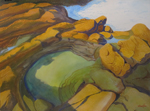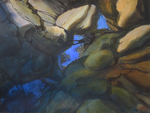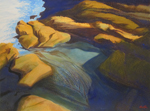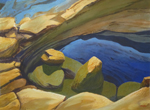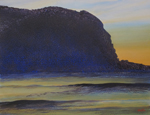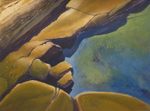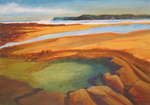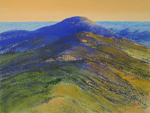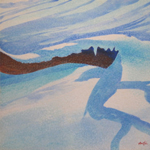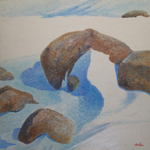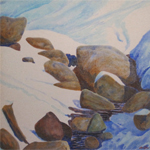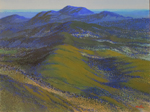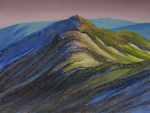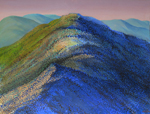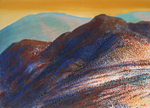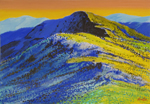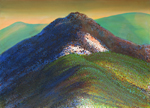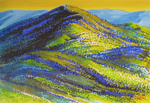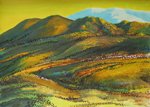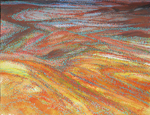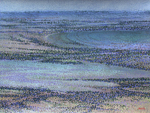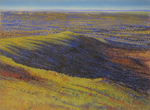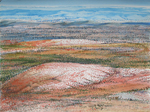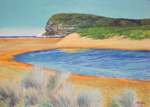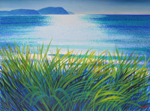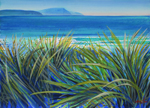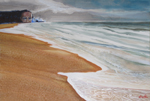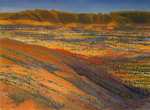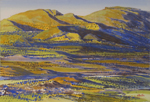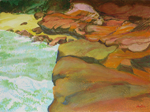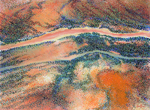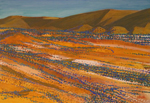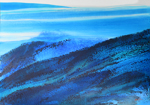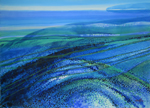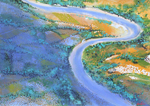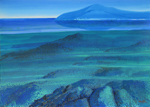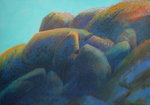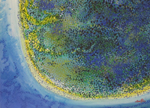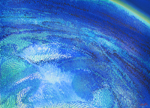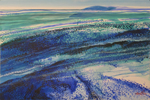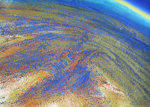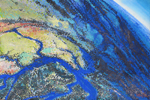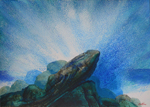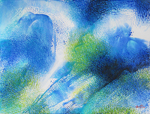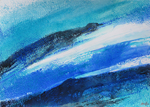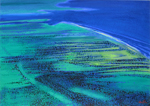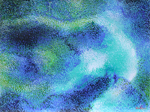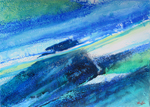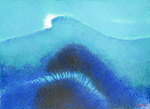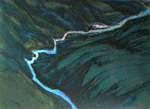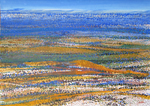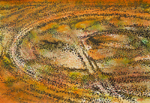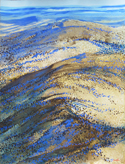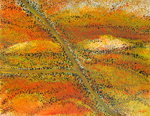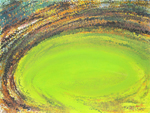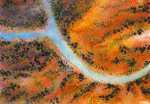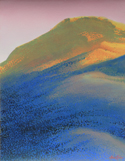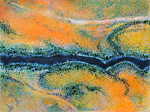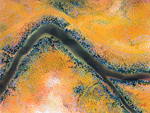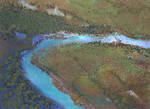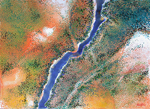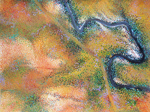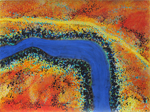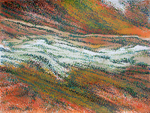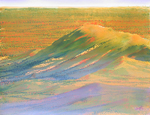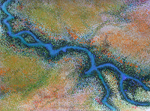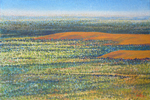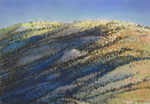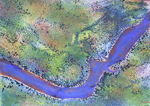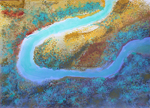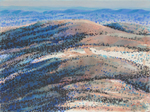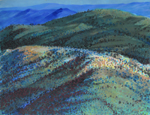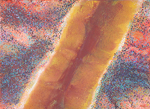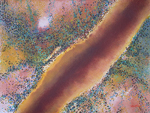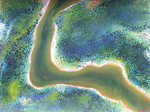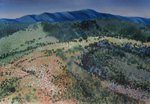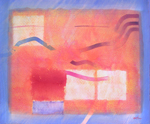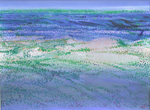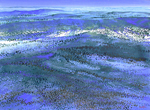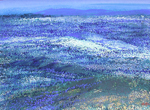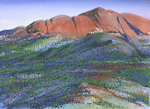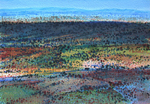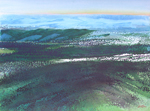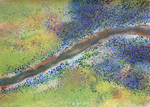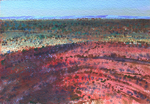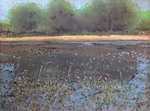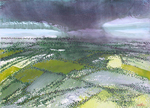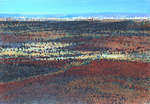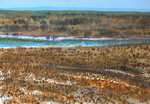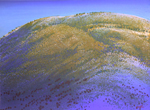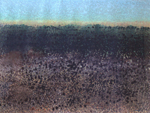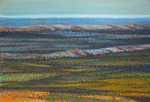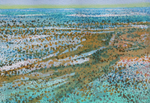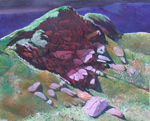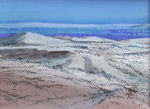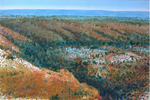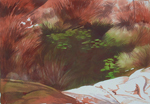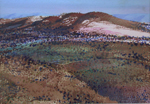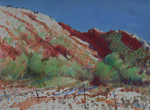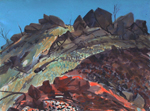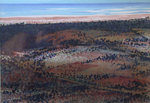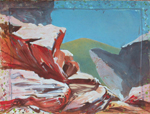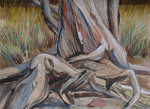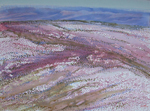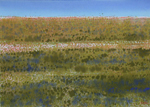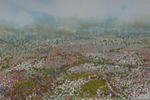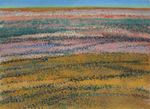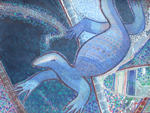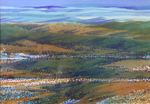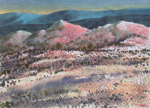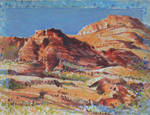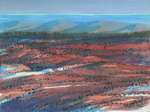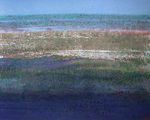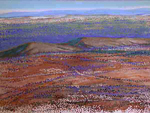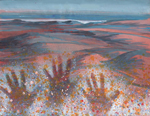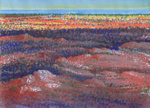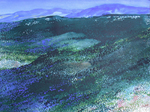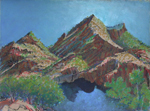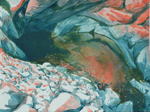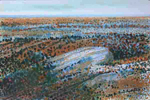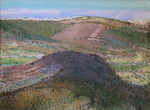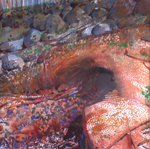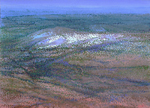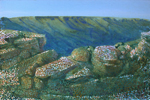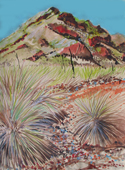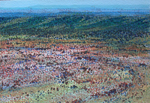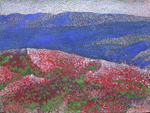The Definition of Watercolour
The Australian Watercolour Institute [AWI] determines the definition of watercolour
quite loosely
as any painting that uses water as a vehicle and/ or consists of pigment that requires water as a soluble agent.
To this effect various mediums used separately or mixed are acceptable such
as watercolour, gouache, acrylic and tempura casein.
Technology has advanced to the stage where water-soluble oil paint is available, which tends to confuse the opportunity of definition.
Paintings may also be enhanced by the use of such materials as charcoal, pencils and pastel.
To draw a strictly definitive explanation to satisfy the purist is to step back into the past.
Tthe AWI however, endeavours to encourage the use of transparent pigment that allows the white paper to
produce the wonderful glow of translucency to the colour.
Impasto techniques of thick, rich pigment are encouraged to a lesser degree.
To confuse the issue more, some artists experiment with other transparent
mediums that result in
a watercolour look to their work.
In summary, the final definition is quite subjective and requires a degree
of “nous”.
The old proverb comes to mind - “rules are made to be broken” - but by how much?
- Graham Austin, AWI Emeritus President
Graham Philip Austin Watercolour Paintings
Watercolour paintings are often mistakenly thought of as fragile and feminine, therefor of secondary importance to the tough,
masculine oil medium. And then there are acrylic paintings somewhere in between.
To complicate things even more some artists
use transparent washes of acrylics to create their watercolour paintings.
However, this being said many continue to regard watercolour paintings secondary to oils.
Why is it we are so forgiving of oils that have cracked, flaked or darkened with time?
By comparison we forget about the ancient manuscripts [which fall into the watercolour category and
created before any knowledge of acid free papers used today] having survived for centuries with sensible care.
This overpowering belief, perpetuated over the years, that watercolours should
be regarded as secondary is
surely one of the art world’s haunting urban myths. All three mediums, acrylics, oils and watercolours are
deserving of equality and balance of stature. On the one hand the masculine oil medium
celebrates its harshness of texture, colour and possible grotesqueness whereas,
watercolour rejoices its natural subtleties, poetic luminosity and glorious spontaneity.
Acknowledging the qualities of both is yin and yang, a natural balance.
Perhaps the imbalance of perception apart from a generally lower price structure,
has sprouted from
the outspokenness of artists who deny watercolour as their oeuvre because of its difficult technical idiosyncrasies.
Many brush aside their own inadequacies by saying “I don’t bother myself with watercolour”. The fact is those who can do and revel in the experience.
Graham Austin's watercolours, like his Acrylics and Oils, also emphasise the aerial drama of the Australian landscape.
His watercolours give the dextrous impression of having fallen off the brush onto the painting surface with
washes of workmanlike elegance and incorporating his tradition of spotted textures.
Graham’s watercolours may show a forest of green spots, shadow linked,
flowing like a current over a fringe of red ochre.
The existence of borrowed colours, intermixed and settled into the local colour helps the production of his visual poetry.
His watercolours adopt some of the attributes of his acrylics. He thoroughly
rejoices in
the luminosity of colour washes, encouraging the glowing effect from white paper instead of using white pigment.

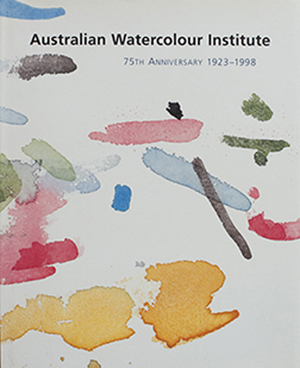 A
A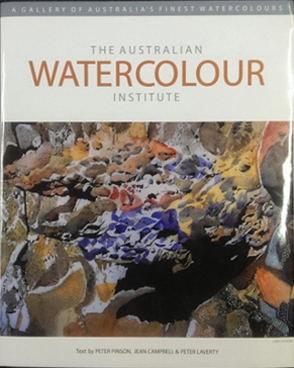 A
A
An introduction to the Australian Watercolour Institute
Extracted from Book 1: AWI, 75th Anniversary 1923-1998
Almost everybody, at sometime, has made an attempt to paint in watercolour,
be it as a child with a cheap paintbox and brush or as a fascinated adult wishing to have a dabble.
Having a surviving interest and a genuine appreciation encourages the watercolourist to continue struggling with its
contrary habits and adversities. Variations in watercolour paper also adds to its complexities.
Making a mistake in watercolour, to a purist, is to err in the greatest sense of the word.
To attempt to correct that mistake is often a sure road to greater failure.
Whereas to err in oils or acrylics is just a matter of cover up. With watercolour, if the mistake
refuses to work for the painting the result is declared a disaster.
Those artists who say, ‘I don’t bother myself with watercolour’ may have good reason to ignore its challenge.
Whilst those who throw down the gauntlet often become addicted. Those who can, do.
Too often, many painters become absorbed with the spontaneity of the medium and attempt to build their works totally out of watery gimmicks more for gimmicks sake.
The real essence of the medium’s spontaneity is to test the drawing talents of the painter by interlocking imagination.
In watercolour painting, poor drawing, even in abstraction, displays itself like food stains on a necktie.
Watercolour demands the highest standards possible within its uniqueness and requires incredible control like a wild animal to the circus trainer
and yet it sits akin to handwriting. Put a ballpoint into the hands of a hundred people and you receive a hundred handwriting styles. So it is with proficient watercolourists.
Art lovers who truly appreciate the excellence of a masterly watercolour must surely recognize the
annual exhibition of the Australian Watercolour Institute as the pinnacle of watercolour exhibitions in Australia.
Each exhibition is no exception as the AWI soars to new altitudes.
The incredible, self dependent painting styles proudly displayed in AWI exhibitions, vary like the individual characters responsible for their creation.
Ranging in size and executed from the technically pure, traditional gems to the exploratory masterpieces of abstraction,
our exhibitions offer a glorious smorgasbord of visual poetry.
Some works manifest their own version of power and glory whilst others revel in their subtleties, wafting lyrical before our eyes.
AWI exhibitions are a gallimaufry of water-based paint on paper, demonstrating an unlimited versatility of technique
as the AWI willingly turns its back on negative criticisms, sometimes espoused by insensitive non-believers of the medium.
Throughout society people of like minds have clustered to share their common interests.
Many art institutions and societies have been formed over the years and many have faded out of existence almost as quickly as they have appeared.
We are proud not only to have survived since 1923 but to have continued building on the beliefs, obsessions and passions of the AWI founders
.
Owing to enthusiasm, hard work and perfectionist attitudes of AWI committees and members throughout the last eighty years plus since 1923,
the AWI continues to emerge as a quietly achieving monarch in the history of Australian art.
This statement is enhanced by browsing through the list of past and present members and recognizing names of importance.
AWI Members are particularly appreciative and thankful for those who have willingly,
diligently and enthusiastically donated their time, energy and material.
Graham Austin OAM
AWI Emeritus President and Life Member
AWI President, 1989-2003
Graham Austin
AWI President 1989–2003
Extracted from Book 3: AWI, Brushes with History, Masters of Watercolour
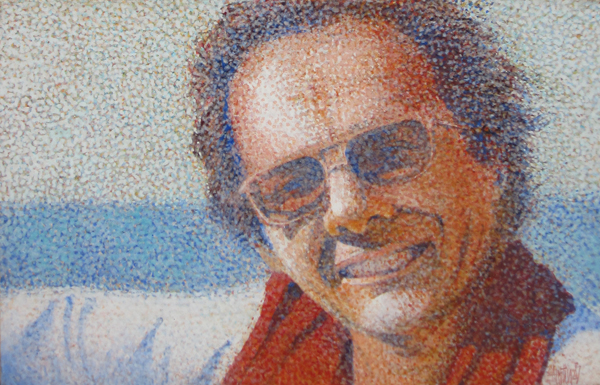
Graham Austin Self-portrait 1987 synthetic polymer on canvas 92 x 61cm
Those artists who say, ‘I don’t bother myself with watercolour', may have good reason to ignore its
challenge, whilst those who throw down the gauntlet often become addicted. Those who can, do.
Graham Austin, Introduction, Australian Watercolour
Institute 75th Anniversary 1923-1998, The Beagle Press, 1998
On Sunday, 26th March 1989, John Caldwell emerged from the AWI Annual General Meeting and telephoned
Graham Austin at home to ask if he would accept the office of President.
Owing to family imperatives, Austin had been unable to attend that meeting but responded that he would be honoured to do so.
Although he had anticipated a tenure of three years, it extended to fourteen, giving him the distinction of being the longest serving president in the history of the Institute.
Graham Philip Austin was born on 29 August 1941 at Women’s Hospital, Crown Street, Surry Hills, Sydney.
The name on his birth certificate had been recorded as Michael John Wood but, two months later, was legally changed by his adoptive parents,
James Henry Philip Austin, departmental foreman, and Phyllis, née Wharton. Austin recalls that,
while playing outside at the age of four, he was summoned by his parents and informed that he had been euphemistically ‘chosen’ as their son.
For the next sixty years, having been dissuaded from pursuing the matter of his origins, he would know nothing of his biological parents.
In the interim, James and Phyllis Austin conceived a child of their own.
It wasn’t until 2003, under the provisions of the Adoption Information Act, that Austin obtained a copy of his original birth certificate
bearing the name of his biological mother, Clarice Edna Wood, aged twenty, then domiciled in Granville.
Extensive genealogical research yielded further relevant information and, with a view to tracing family members,
Austin placed an advertisement in the ‘Search’ column of the Daily Telegraph, which appeared on 24 October 2003.
That same day, he received an email advising him to contact Clarice Wood’s younger sister, Shirley.
The sensationalism of the story she would recount concerning the circumstances surrounding Austin’s birth,
replete with secrets, betrayal, adultery and murder, was worthy of a supermarket tabloid.
The third of six children, Clarice Edna Wood, known as Tess, was born in 1920 to Norman John Wood and Susannah Jane, née Poole.
According to family oral tradition, Norman Wood’s father, Alexander Robb (Robert) Wood, born on 15 November 1859 in Auchterless, Aberdeenshire, Scotland,1
served as an engineer in the British Army during the Zulu Campaign in South Africa but deserted
and subsequently emigrated to Australia, settling in Moss Vale, New South Wales.
On 18 July 1887, in Sydney, he married Ellen Agnes Cushan, with whom he had two sons, the eldest being Norman.2
During the throes of the Great Depression, Norman Wood, who operated a secondhand furniture business in the Sydney suburb of Canterbury,
struggled to provide for his large family. When his wife, Susannah, succumbed to breast cancer in 1933,
Tess and her elder siblings left home to fend for themselves while the two youngest daughters were consigned to the Burnside Presbyterian Orphan Homes.
Shortly after the start of the Second World War, Tess and her sister, Mavis, fell pregnant to the same young lothario,
British-born Frederic John Axford. Mavis, unaware of Tess’s condition, wed Axford on 1 March 1941 in Bankstown, New South Wales,
whereas the unmarried Tess sought refuge in the home of a caring aunt in Granville, who solicitously guarded her secret.
On 29 August 1941, Tess gave birth to a son, whom she called Michael John Wood before relinquishing him for adoption,
and her sister, Mavis, likewise bore a son only two days later.
Clearly, this created complex family relations whereby Austin’s father, Frederic Axford, was also his uncle and Austin’s first cousin his half-brother.
Tess later married and relocated to South Australia, where she had two more sons.
In an ironic twist, her second youngest sister who was assisting Clarice during her last pregnancy, would conceive a child with Tess' husband.
Austin’s father, Fred Axford, a popular preliminary boxer and sparring partner of champion pugilist, Vic Patrick, worked as a private investigator.
On the night of 27 May1956, while peering through the window of a private residence in Castlecrag in the course of a divorce investigation,
Axford was pursued by an occupant of the house and stabbed to death in a nearby gutter.3
His assailant, a 43-year old Dutchman, was acquitted of the charge of manslaughter, having testified in evidence that
he believed Axford to be a burglar or ‘pervert’ when he chased him from his home.4
Upon his death, Frederic John Axford, age 33, of Christian Road, Punchbowl, left a wife, three legitimate children,
an illegitimate son, about whom he would never know, and an estate with a probate value of £140.5
Tess, had died in 1996 but her surviving sister, Mavis, warmly welcomed her new-found nephew to the fold,
as did all the members of his biological family, with whom he now maintains close contact.
Austin’s adoptive family presented a contrast by virtue of their conventionality, providing him with a stable and
financially comfortable home life in the leafy, salubrious, Sydney suburb of Russell Lea, on the Parramatta River.
Although Jim and Phyllis Austin were strict disciplinarians, in retrospect, he considers himself fortunate for the positive opportunities they offered him.
The proverb so often repeated by his father, ‘If a job’s worth doing, it’s worth doing well,’ still resonates in his mind, Austin says, like a mantra.
A fitter and turner by trade, Jim Austin was an airplane enthusiast. During the Great Depression,
he would walk from Rozelle to Mascot with a friend to work on Charles Kingsford Smith’s aircraft gratuitously to gain work experience.
Both men were later employed by the Commonwealth Aircraft Corporation, attaining management positions.
In 1947, while spending their annual family holidays camping at Lake Tabourie on the South Coast of New South Wales,
a seaplane landed on the lake and the pilot offered joy flights to interested campers.
Eager to pass on his affinity for aircraft to his son, Jim Austin took advantage of the proposal.
The visual experience of that first adventure in the air would remain vivid for Austin throughout his life,
later becoming the dominant aesthetic influence in his practice as an artist.
Adopting an atavistic approach to landscape painting, Austin employs a gallimaufry of pointillist dots to evoke the
primitive pattern of the earth’s topography viewed from an aerial perspective.
In its spirit and aesthetic effect, his imagery often relates to aboriginal iconography and land mapping.
The early talent for drawing Austin demonstrated was encouraged by his parents, his father having been an amateur oil painter in his youth.
It was with some surprise that Austin later learned that his biological mother, Tess, had painted flowers on china plates as a hobby.
After completing his high school education, he was employed as a junior artist in a display company,
attending evening art classes at the National Art School from 1958 to 1963. Among his first tutors were
Jocelyn Maughan and Brian Stratton OAM, both AWI members. Later, Maughan encouraged him to teach drawing part time at Meadowbank Technical College,
where she was Head of the Art School. Concurrently, Austin’s junior artist position had developed into a successful career in
advertising as an art director and creative director, responsible for copywriting, designing and illustrating,
at leading agencies such as George Patterson’s, Weston Advertising, and SSC&B:Lintas.
Meanwhile, Austin continued to pursue his activities as a painter and, in 1962, was awarded the first of his more than thirty-five art prizes,
winning the watercolour section of the inaugural Drummoyne Art Prize.
Two years later, he won the watercolour prize in The Mirror Waratah Festival Art Award. Other winners in that competition became AWI colleagues,
notably Guy Warren, Hector Gilliland (then AWI Vice President) and Peter Pinson (later AWI President).
A major award came in December 1968 when he won the Sun Newspaper Police Commissioner’s Road Safety Poster Competition,
first prize being a Holden Torana automobile and a $200 bank account.
In 1970, Austin moved to Cromer Heights, on the northern beaches, with his first wife, Thelma.
Together, they adopted a boy and a girl. His second wife would bear him another daughter.
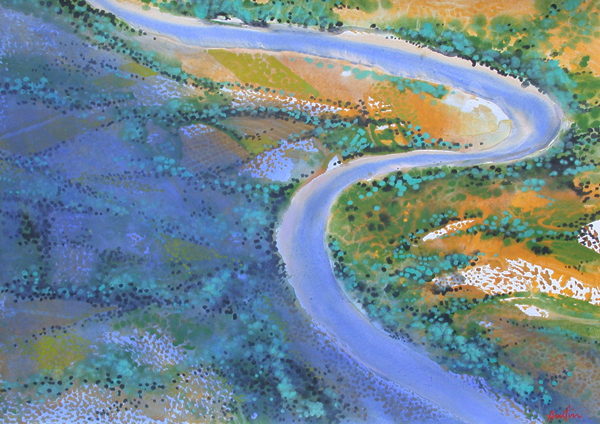
Graham Austin Afternoon Shadowing 2007 Watercolour 76 x 102cm
From 1966, Austin exhibited with the Australian Watercolour Institute and was elected a member in 1972,
later serving on the Executive Committee under Brian Stratton OAM. His prior experience as foundation president of the
Drummoyne Municipal Art Society (1964-1967), president of the Peninsula Art Society (1986-1989),
representative for the arts on the Warringah Bicentennial Committee (1985-1987) and
committee member of the Manly Art Gallery and Museum (1991-2001) rendered him
well equipped to take the helm of the AWI, which he judiciously steered.
In the first nine years of his stewardship of the AWI, Austin generated a 347.5% rise in AWI accumulated resources by
increasing the sales commission by 2.5%, to realise a small share from the painting sales,
and doubling the membership fee from $25 to $50 per annum. This was instrumental in securing sufficient funds to produce,
on his own initiative and effort, the Institute’s first book, The Australian Watercolour Institute 75th Anniversary 1923-1998, published by The Beagle Press
with a foreword by Dr Brian Kennedy, Director, National Gallery of Australia, which was of inestimable value
in the promotion of the Institute and its members. The majority of the 1500 books published
were sold so that the production costs were recuperated, effectively putting the AWI on a solid financial footing for the future.
One of Austin’s goals, like that of his predecessors, was to investigate the possibility of finding permanent premises for the AWI.
Considerable time and energy was expended in this pursuit with disappointing results due to the elevated cost of
Sydney real estate in relation to the Institute’s finances. His other goals, however, were admirably achieved,
particularly in relation to establishing an international presence. Under Austin’s presidency, the AWI participated in the
International Watercolour Biennial at the Museo Nacional de la Acuarela in Mexico City (1990,1994,1998, 2002)
and the Biennial Watercolour Exhibition in Busan, Korea (2002).
The AWI also exhibited at Wagner Gallery, Hong Kong (1996) and
conjointly with The Federation of Canadian Artists in both Canada and Australia (1992, 1993).
The organisers of these exhibitions received government sponsorship and
provided high quality, colour catalogues illustrating exhibitors’ works.
During the earlier years of Austin’s term as president, AWI annual exhibitions were held at the S.H. Ervin Gallery,
attracting large and approbative audiences -- a third of the works, on average forty to fifty paintings, being sold.
Dr Brian Kennedy, Director, National Gallery of Australia, opened the successful,
celebratory AWI 75th Anniversary Exhibition at the S.H. Ervin Gallery in 1998.
However, subsequent to the 1999 annual exhibition, changes in the directorship, curatorial policy and direction of
the S.H. Ervin Gallery inevitably culminated in a quest for another venue.
From 2001, AWI annual exhibitions would be held alternately at Gosford Regional Gallery and Mosman Art Gallery.
In addition to the annual shows, Austin organised exhibitions at Newcastle Regional Gallery (1991),
Wollongong City Gallery (2002) and Wagner Gallery (2001, 2002), where Peter Laverty,
former director of the Art Gallery of New South Wales and previous AWI Vice President,
delivered a superlative opening speech on 11 September 2002, just hours before
coordinated terrorist attacks destroyed the Twin Towers of the World Trade Center in New York.
In 2003, to mark the AWI 80th anniversary, a website was created, primarily based on the contents of
the 75th anniversary book, with the objective of promoting the Institute, its members and their work.
The warmth, humour, probity, magnanimity and vision that characterised Austin’s role as president endeared him to all.
In recognition of his extraordinary contribution to the Institute, Austin was made a Life member in 1997.
Apart from his professional activities, Austin has been a Freemason for almost fifty years,
having followed his adoptive father into that fraternal organisation.
Exercising his exceptional marketing and advertising skills, he served for twenty-seven years
(fourteen as vice president) on the Board of the Masonic Youth Welfare Fund, now called
‘A Start in Life’, raising substantial charity dollars for needy children.
Graham Austin was awarded the Medal of the Order of Australia in 2006 for
service to the visual arts as a painter, particularly through the Australian Watercolour Institute.
His work is held in public and private collections in Australia, the United States, the United Kingdom,
the Netherlands, Hong Kong, Singapore, Malaysia and Japan.
ENDNOTES
1 National Records of Scotland, Statutory Births, Registration Number 173/00 0083.
2 Australia Marriage Index, 1788–1950, Registration Number 870.
3 The Argus, 28 May 1956, p. 5.
4 The Canberra Times, 13 October 1956, p. 11.
5 New South Wales, Australia, Index to Deceased Estate Files, 1923–1958, B147245
- Linda van Nunen
Australian Watercolour Institute l brushes with history
Graham Austin OAM Australian Fine Artist:
Acrylics, Oils and Watercolour Paintings
Awarded Order of Australia Medal [OAM] 2006
Australian Watercolour Institute [AWI], Emeritus President
Member of Australian Watercolour Institute (AWI), since 1972.
AWI President from 1989 to 2003.
AWI Honorary Life Member since 1997.
President of Peninsula Art Society from 1986 to 1989.
Foundation President/ Senior Vice President of Drummoyne Art Society 1964 to 1967.
Other Website Links of Interest:
Australian Watercolour Institute www.awi.com.au
Artsite Gallery www.artsite.com.au
KAB Gallery, Terrigal www.kabgallery.com.au
Greenhill Galleries Adelaide www.greenhillgalleriesadelaide.com.au
Electronic Cottage Art & Craft Gallery www.electroniccottage.com
Juried Online Art Festival www.jolaf.com
Indigo Art www.indigoart.com.au
Brian Dunlop www.briandunlop.com
John Caldwell www.waragilstudios.com.au
Bernd Heinrich www.berndheinrich.com
Roger Murphy www.rogermurphy.com.au
Guy Troughton www.guytroughton.com
Robert Wade www.ozemail.com.au/~rawadw
Wendy Bookatz www.wendybookatz.com
Saatchi-gallery www.saatchi-gallery.co.uk/
Artarmon Art Gallery www.artarmongalleries.com.au
Christchurch
Art Gallery New Zealand www.christchurchartgallery.org.nz
Gosford Art Gallery www.gosfordregionalgallery.com
HotFrog
Australian Business Directory www.hotfrog.com.au
Wagner Art Gallery www.wagnerartgallery.com.au
David Rex-Livingston Art Dealer www.rex-livingston.com
Galeria Aniela Fine Art Gallery www.galeriaaniela.com.au
Royal Art Society www.royalart.com.au
Royal Scottish Society of Painters in Watercolour www.rsw.org.uk/
Royal Watercolour Society www.royalwatercoloursociety.co.uk/
Saatchi Gallery Britain www.saatchi-gallery.co.uk
Ulster Watercolour Society www.uws.org.uk


